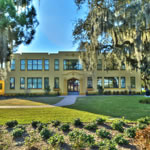As part of an initiative to make Manatee County, on the west coast of Florida, a welcoming and sustainable community for residents and tourists, the county recently renovated two civic buildings—an historic courthouse and an old schoolhouse—to LEED Gold standards.
Approximately 330,000 people call Manatee County home, but thousands more visit to enjoy the weather and wildlife. Nestled between Tampa, St. Petersburg, and Sarasota, Manatee County aspires to be known as the “real, authentic Florida,” an experience that can be diluted at other tourist destinations. This particular branding campaign began in 2012, but collaboration between the county’s departments on sustainability matters has been happening for the past five years, says Brenda Rogers, director of the community services department.
Many of Manatee County’s green initiatives are led by its Green Team, a group of county employees from different departments established to help the county government be more environmentally friendly. These efforts are often driven by the local economy, says Darryl Blair, the coordinator for the building management division of the property management department. He says the recent retraction in the construction industry has had a significant impact on the county’s budget. As a result, energy and water conservation have become a priority.
According to Tom Yarger, construction services manager for the property management department, the Green Team began by investing in chiller plants, reexamining construction practices, and exploring retrofit opportunities. “Little things like converting to different light bulbs doesn’t seem like it would make a big difference, but when you multiply them across the 380 buildings Manatee County owns and maintains, it is a huge savings,” Yarger says. The money saved operationally was redirected to serve the community in other ways.

Green efforts in Florida’s Manatee County include water-conservation projects that have saved $350,000 to date and the use of 25,000 tons of reclaimed infrastructure to create habitat for marine life.
In the overhaul, the county’s biggest energy users were targeted, including the historic courthouse and schoolhouse. Yarger says the dated systems as well as the worn-out windows and roof caused the buildings to leak energy—and therefore money. Local contractors installed new HVAC systems, low-E glass windows, insulated ceiling tiles, and more. All of the restorations and upgrades brought both buildings to LEED Gold standards. The now energy-efficient schoolhouse was transformed into a community center. “We took a building set for demolition and made a space that has a positive impact on the community,” Rogers says.
Manatee County also has worked on enhancing its recycling program by educating its residents. As a result of the county’s efforts and the community’s participation, the people of Manatee County have extended the life expectancy of their landfill by 30 years or more.
Recycling has other, more unusual benefits as well. Melissa Nell, manager of the volunteer and education division for the natural resources department, tells the story of when a neighboring county was dismantling an old bridge. Manatee County took the concrete foundations and bridge span and sunk it in its waters to bring new habitat to their artificial reef. “The offshore reef and the fish attracted to it, creates a desired location that brings people to our area for vacation and recreation,” Nell says.
The parks and preserves are included in the county’s sustainability initiatives with restoration efforts currently under way at 16 properties to improve the habitat as well as air quality, water quality, and overall quality of life. “If you take time to restore these sites and integrate them into the community,” Nell says, “it’s something people will value for a long time.”

